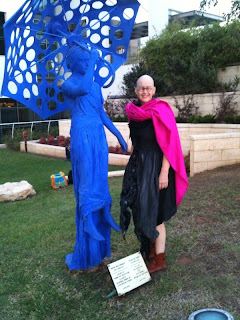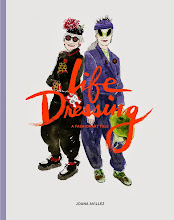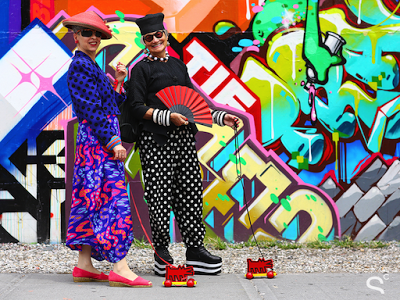 We are taught from an early age how to dress for most occasions, either by instruction or by example. Brides wear white; mourners wear black. Corporate America wears a dress or suit most days of the week, and jeans or chinos on casual Friday. When invitations specify "business attire", "black tie" or "festive dress" we know how to dress appropriately. We follow these dress codes so that everyone in the group feels comfortable, and everyone has an idea of each member's role at an event.
We are taught from an early age how to dress for most occasions, either by instruction or by example. Brides wear white; mourners wear black. Corporate America wears a dress or suit most days of the week, and jeans or chinos on casual Friday. When invitations specify "business attire", "black tie" or "festive dress" we know how to dress appropriately. We follow these dress codes so that everyone in the group feels comfortable, and everyone has an idea of each member's role at an event.But when life invites you to chemotherapy, what do you wear?
Usually this blog centers on Jean and Valerie, the Idiosyncratic Fashionistas. Today it focuses on Orly Ginossar, wife, mother, artist, international traveler, Israeli citizen, woman of rare style, and breast cancer patient.
Never one to shy away from a challenge, Orly rose to the occasion with strength and creativity. Illness forces us to compromise on many fronts, but Orly drew the line at giving up her very personal style. She adopted some of the tricks that previous cancer patients pioneered - for example, eyebrow pencil to draw in eyebrows that have disappeared, and earrings to distract the eye. But she pointedly rejected others, such as wigs and head scarves, and came up with a few tricks of her own. In particular, for the course of her chemotherapy treatments (eight in all, between July 1 and November 4), Orly began to wear pink (echoing the breast cancer pink ribbon), and even went so far as buying a pink cover for her laptop and painting her bedroom a dusty rose pink to raise awareness in her home. She and her family have been documenting her adventures in breast cancer. In this week's Idiosyncratic Fashionistas, Orly tells us what she wore to chemo and why.
 In this photo, Orly wears a pink shawl over a black dress. The shawl is actually a length of wild silk cut straight from the bolt. This was not merely a fashion statement or a political statement: it kept her skin covered outdoors, since she was told to avoid exposure during chemotherapy; it functioned as a mask in crowded areas, since her resistance was low; and it helped keep her warm in the air conditioned hospital.
In this photo, Orly wears a pink shawl over a black dress. The shawl is actually a length of wild silk cut straight from the bolt. This was not merely a fashion statement or a political statement: it kept her skin covered outdoors, since she was told to avoid exposure during chemotherapy; it functioned as a mask in crowded areas, since her resistance was low; and it helped keep her warm in the air conditioned hospital.Orly's cotton dress from Turkey is of different lengths and can be worn both backwards and forwards. She wears it here with brown leather Trippen shoes with turned up toes. Her glasses are by Theo and her "Owlita" feather earrings were found on Etsy from Annieland. "I never wanted to look ill", she says. "I always wanted to look perfect."
Unafraid to bring attention to her smooth scalp (which she shaved herself, rather than see her blond hair slowly fall out), in the photos above and below, Orly wears a floral headband with looped petals made of vintage kimono fabric, as well as a necklace of the same material, both purchased on Etsy. Her black shirt is by Express Design Studio, and her unlabeled black skirt is from a second hand shop in Boston, where Orly lived while her younger daughter was attending the Berklee College of Music. Underneath the black skirt are two black tutus and a contrasting white felt skirt (no label). The black boots, by Trippen, were bought during a trip to Belgium, and the red felt flower earrings, also from Belgium, are by Silvana Riva. Most of Orly's wardrobe was already in place before her diagnosis. Additions have consisted primarily of earrings and wraps.
Below Orly wears her pink silk shawl over a red silk top made of two triangles, with matching harem pants by RetroReproHandmade, available through Etsy.
The straw earrings, from a street vendor in New York City, play off the necklace of cloth circles. Orly asked her friends everywhere to send her large, bold, cheap, colorful earrings. This is not only a very positive approach to both cancer and style, it's also an excellent way to keep friends involved and allow them to be active participants in the road to recovery.
In the zen-like pose here, Orly makes chemo look easy, although she admits that it isn't. During chemotherapy, she was warned to avoid any kind of injury, including insect bites, injections, cuts, plants with thorns, splinters, and even blood pressure checks. Naturally outgoing and friendly, she was advised to avoid people while her immune system was compromised. Everyone who visited had to wash their hands as a precaution.
"But I decided that I should make it easy for myself and be as positive as possible (hard!!!!!) in order to gain quality and ... strength." Her unique style, one facet of her positive attitude, was noticed by everyone around her. "Everybody has a comment", she says. Fellow cancer patients say "You show us the way", "You have a lot of courage", and "I wish I had done this". A nurse told Orly she had never met anyone like her, saying she brought "so much liveliness, so much hope". Orly has seen people react to her with smiles, laughter, and even tears. On the streets, people unaware of Orly's condition compliment her on what they believe is simply an avant garde hairstyle. (Orly says she intends to continue shaving her head after treatment is completed.)
In the photo below, Orly wears cold mittens and shoes at chemo. These bring down the temperature of her hands and feet, and for several hours following the procedure she is not allowed to use shoes, socks, gloves or blankets. This treatment helps to prevent possible later nerve damage that could be caused by the toxicity of the chemicals.
Below, Orly wears a wool sweater with lace-like designs by Kedem Sasoon. The shape is so flexible that she can wear it upside down, as shown here. The felt scarf is from Etsy, and the necklace of red and black felt balls was bought in Switzerland. The clear plastic ice cube shaped earrings are perfect for the Theo glasses. The skirt, by Odille, was bought at a second hand shop in Boston; the fabulous shibori tights from a "junky shop" in Israel. The black boots with fake fur trim are by Trippen. All the outdoor photographs were taken at The Davidoff Center at Rabin Medical Center, whose beautifully groomed and thoughtfully laid-out grounds seem to have been designed to bring a sense of pleasure and contentment to a place that many people - understandably - tend to associate with anxiety.
Here Orly wears a bright blue feather boa interspersed with ribbons, available in Tel Aviv by the meter.
 The 100% cotton multicolored men's striped shirt by Muji, very comfortable against sensitive skin, is color coordinated with a necklace of cloth rings (all "happy colors", says Orly). The glasses, by Teffany, are about thirty years old. The short black felt jacket is from a second hand store.
The 100% cotton multicolored men's striped shirt by Muji, very comfortable against sensitive skin, is color coordinated with a necklace of cloth rings (all "happy colors", says Orly). The glasses, by Teffany, are about thirty years old. The short black felt jacket is from a second hand store.Now that the chemotherapy is complete, Orly feels herself getting stronger on a daily basis. Always in search of a new idea, she had a small yurt built in her garden, where she can meditate, entertain friends, and draw strength from the earth.
As for her post-chemo style, Orly says "Pink is over." Three weeks of radiation therapy will start shortly, and end just before the new year, leaving all of 2010 open to new beginnings, and new adventures - the kind one can embrace with relish.
All photos by Orly's son Itamar, 17, and her husband, Shaya (a man of a certain age).










